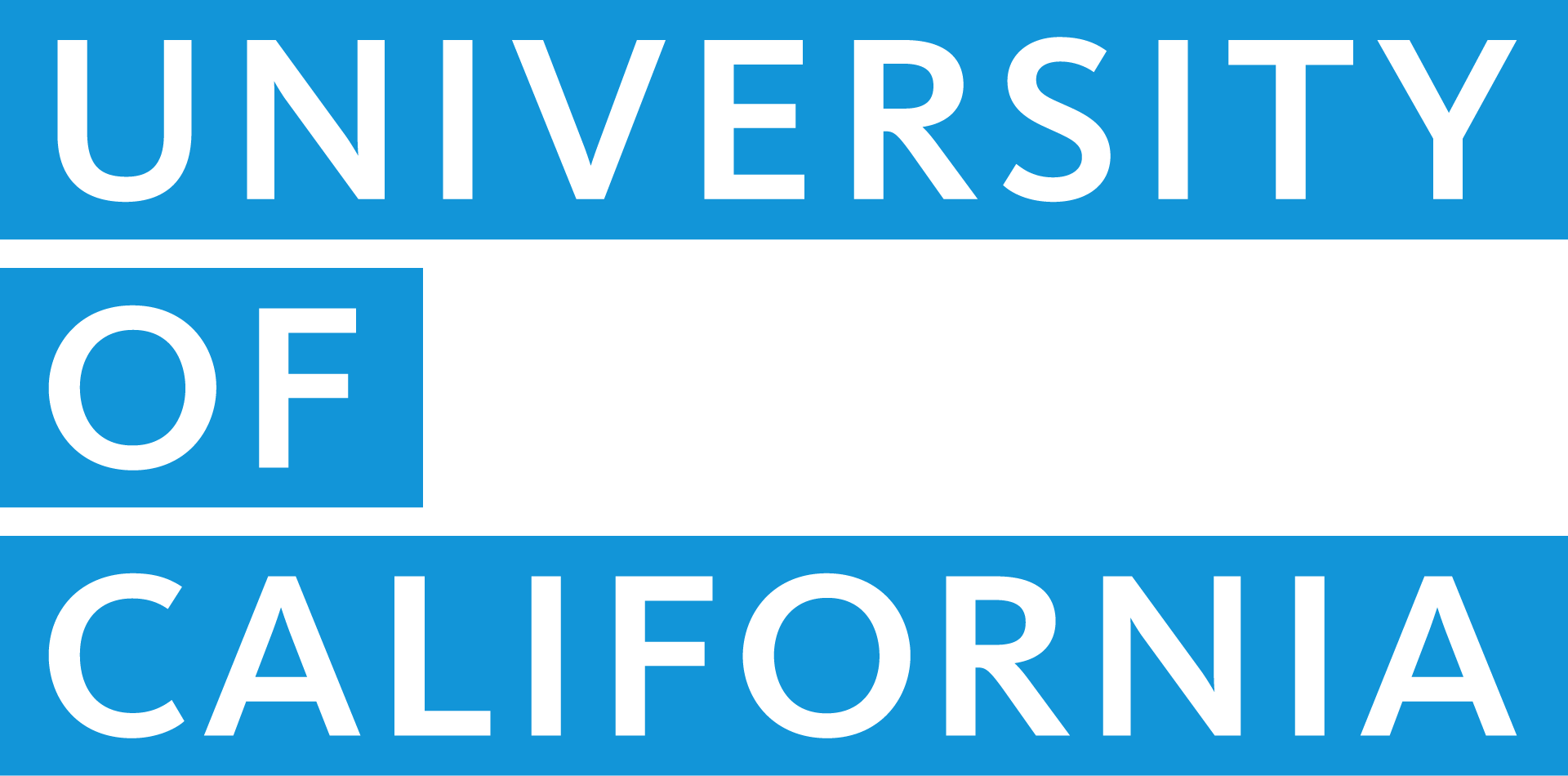UC People: Mohamad “Mo” Saatara, Olympic coach
Share This Article
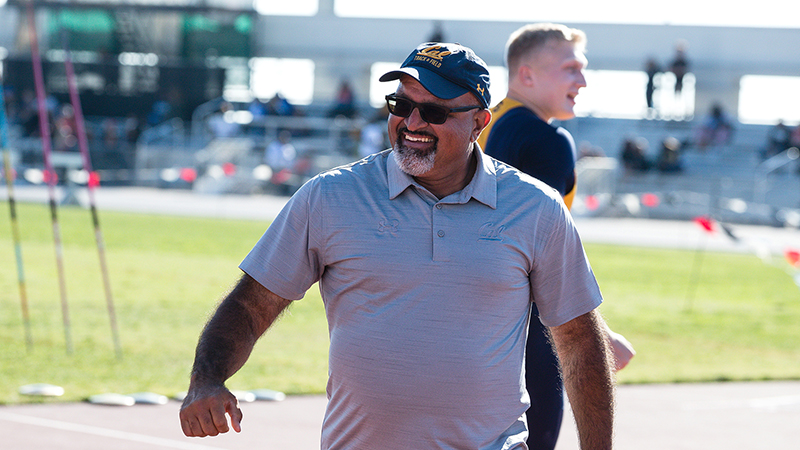
By Anne Brice, UC Berkeley
It was the second meet of the 2024 Oklahoma Throws Series. Wind conditions in the tiny town of Ramona on the April day were perfect, and UC Berkeley junior Mykolas Alekna was throwing the discus with his usual explosive energy, thinking: Maybe today will be the day.
And then it was: The 21-year-old shattered the world record in discus.
“When that happened, we were screaming and jumping up and down,” said Nick Godbehere, a rising junior who competes with Alekna on Cal’s throws team. “We just went crazy because it was such a big deal — it was one of the oldest and hardest world records to beat.”
At 74.35 meters, Alekna’s throw was the farthest in discus history by 11 inches. The previous world record was set by East Germany’s Jürgen Schult in 1986. Alekna’s dad, Virgilijus Alekna, a two-time world champion and Olympic gold medalist, held the second best discus throw on record.
And now, Berkeley’s Alekna holds the top spot.
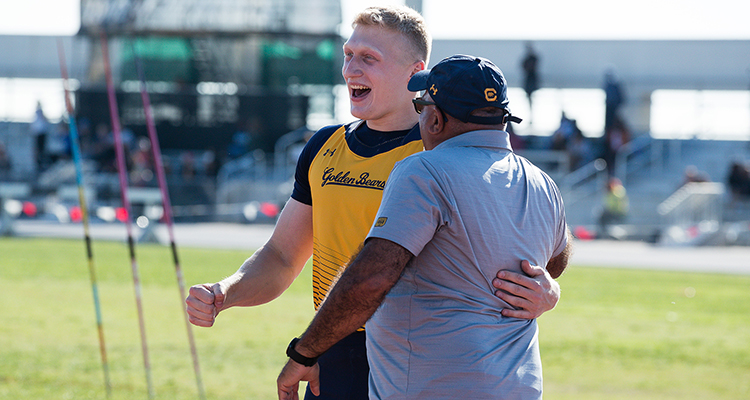
Mohamad “Mo” Saatara is Cal’s track and field assistant coach for the throwing program, made up of 22 student-athletes and three elite professional athletes who compete in discus, javelin, shot put and hammer throw. He said Alekna, who came to Berkeley from Lithuania as a first-year student in 2021, is young to be so talented at discus — top throwers are usually in their 30s and 40s. And at 6 feet, 4 inches tall, he’s not as big as many world-class discus throwers, who typically reach towering heights of 6 feet, 6 inches and above.
But it’s not throwers’ physical characteristics that make them good, said Saatara. While they should be extremely strong, fast and coordinated, throwers of all different sizes can get results, as long as they focus on technique.
“It’s not what you have,” he said. “It’s what you do with what you have.”
It’s that coaching philosophy — focusing on how athletes tap into their individual strengths, rather than forcing them to fit into a mold of what a great athlete looks like — that allows throwers mentored by Saatara to reach heights of success that may have felt out of reach.
And his philosophy has paid off. With dozens of his athletes winning championship titles in the U.S. and overseas, Saatara, with support from track and field director Robyne Johnson, has built a unique team of athletes from seven countries and three states that has sustained elite level success over several years’ time.
“It’s not one-size-fits-all,” said Elena Bruckner, a volunteer assistant coach and post-collegiate discus thrower who trains with Saatara. “There’s so much diversity in strengths and body types and experience and background. Coach Mo works with each athlete to figure out what works best for them.”
In his coaching, Saatara tries to give simple, straightforward feedback that allows his athletes to grow without confusing them.
“Sport is similar to art,” he said. “As a coach, you have to give your athletes the freedom to express themselves in their performance, so their personalities and who they are comes through.”
This summer, Saatara will coach four Cal athletes at the 2024 Paris Olympic Games: Alekna, competing for Lithuania; world champion Canadian hammer thrower Camryn Rogers, who has her bachelor’s and master’s degrees from Berkeley and has been training with Mo since 2018; Rowan Hamilton of Canada in the hammer throw; and Swedish discus thrower Caisa-Marie Lindfors, who’s pursuing a master’s degree at Berkeley in the cultural studies of sport in education.
Saatara said big competitions like the Olympics, where several of his athletes have competed over the years, showcase the “strong competitive spirit” and consistent high-level throwing of his team. He credits his ability to build a solid team to his own coaches in California and later, to traveling overseas to learn from some of the best in the field.
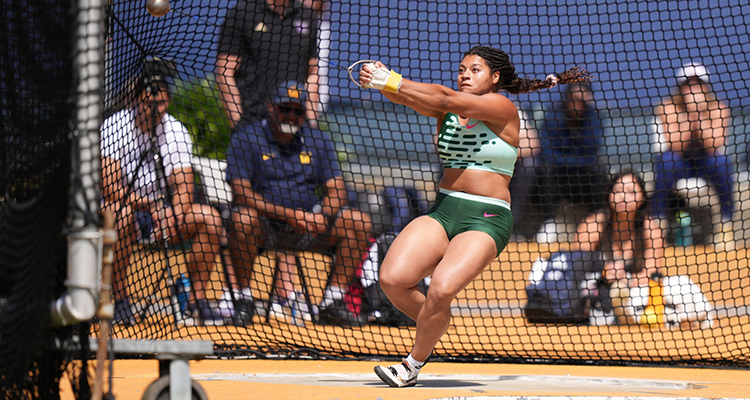
Unlocking greatness
Saatara was born in Iran in 1972. At age 11, during the Iran-Iraq war, he immigrated with his family to the U.S. Eventually, they made a home in Citrus, California, in the San Gabriel Valley.
In the eighth grade, Saatara went out for track and field and learned to throw the shot put. It gave him a chance to be part of a team at a critical time when he was adjusting to a new culture and looking for supportive, challenging environments.
“The coach said, ‘Hey, you’re good at this,’” Saatara recalled.
Saatara continued to compete in throwing events, picking up the discus in high school and the hammer throw at Citrus College, where he was recruited by Lloyd Higgins, who was a professional basketball player and track and field star before coaching, earning two NAIA All-American titles in basketball and three in high jump. After his career as an athlete, Higgins went on to coach for nearly 45 years.
“Coach Higgins had a really big influence on me and was a big part of my life,” said Saatara.
After two years, Saatara transferred to California State University, Los Angeles, where he trained in hammer with world-renowned coach Don Babbitt and competed in the state finals.
When they weren’t training, Saatara and Babbitt would talk about coaching. “I was really interested in how high-performance sport worked and what was involved in developing an athlete,” said Saatara.
After earning a bachelor’s degree in biology and a master’s in exercise physiology, Saatara worked in a research lab with plans to attend medical school. But after several months, he realized the medical profession wasn’t for him. At a loss for next steps, he recalled his fondness for learning how to train elite athletes and thought he could be good at it. So he decided to give coaching a shot.
Higgins, with whom Saatara had stayed in touch over the years, invited the 24-year-old to join him at Citrus College, coaching throwing events.
At the community college, Saatara worked with a group of high school students Higgins had been coaching at the time, and found he really enjoyed it. He relished the opportunity to help young athletes establish a strong foundation of technique that they could build upon in years to come. Several students he worked with, including Berkeley’s Rhuben Williams, went on to have successful throwing careers.
It soon became clear that Saatara had found what he was meant to do. And he wanted to know more — to learn “how great athletes became great athletes.”
The quest to unlock the secrets of greatness took Saatara to Europe, where he traveled in the late 1990s and early 2000s to learn from some of the best throwers and coaches in the world. Throughout history, European countries, like Germany and Hungary, have consistently produced elite throwers.
In his research, Saatara learned that instead of separating the teaching and learning aspect of coaching from the physiological development of an athlete, common in the U.S. at the time, Europeans integrated both aspects to coach the full performance of a thrower.
Back in the U.S., Saatara began to create his own style of coaching, combining his deep understanding of how the body works with a commitment to developing each athlete as an individual, a whole person with unique strengths and weaknesses and the potential to be great.
After runs in coaching at Cal State LA, Northern Arizona University and the University of Michigan, Saatara came to Berkeley in 2013. Now going into his 12th season, he has built a highly successful program that continues to grow, with more than 20 All-American athletes, two NCAA records, four national championships, 10 Pac-12 champions and multiple Cal records.
For his athletes — Saatara has mentored more than 150 over his career — the coach works tirelessly, collecting data and analyzing their throws down to the millisecond. He’s dedicated to helping them be the best they can be, even when it takes dismantling what they know to rebuild them stronger.
Breaking down to rebuild stronger
When Nicholas Godbehere joined Cal’s throwing team two years ago, things didn’t go as he’d expected.
Godbehere grew up in Bakersfield, California, with national champion shot putter parents. They’d coached their son at Shafter High School, and he’d competed in invitationals and all-comers meets around the country, including the Nike Outdoor Nationals, where he placed third in shot put and discus in 2022. So when Godbehere got to Berkeley in the fall of the same year, he felt ready to compete.
But Saatara didn’t put him in. Instead, Godbehere spent his first year developing his technique.
“I felt lost,” said the 20-year-old psychology major. “When you get to college, the shot put gains four pounds. I struggled with it for a long time because the ball felt really heavy to me. No matter how hard I tried, I couldn’t seem to improve the way I thought I would.”
But Saatara didn’t give up on Godbehere. Together, the two worked daily, reorganizing how Godbehere threw so he could move with more speed and use it to his advantage. After a year, the sophomore joined his team in competition.
“It was really frustrating, at times,” Godbehere said. “But Coach Mo stuck with me. It was his constant support and belief in me that kept me working hard and coming back every day. He really saved my throwing.”
Godbehere now throws four meters farther than when he began with Saatara, an unusually big jump in a short time of training.
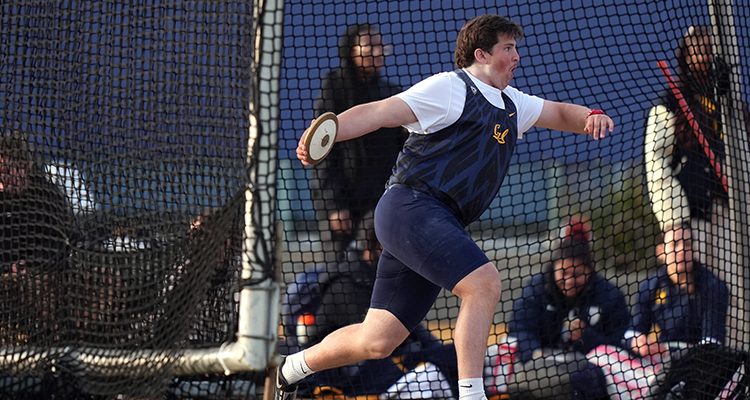
“Mo approaches coaching like an engineering problem,” said Summer Pierson, who trained in discus with Saatara as a post-collegiate professional athlete and served as a volunteer assistant coach until last year. “He has a meticulousness and precision and calculation that I haven’t seen in other coaches. What he does is wildly complex.”
Pierson began working with Saatara in 2014, in the final stage of her throwing career. She’d competed as a student-athlete at Stanford University, and went on to train with a handful of coaches over the years. So she knew what she was looking for in a coach.
“I love to compete and train,” she said. “I just needed a better home and a more knowledgeable person to help me through the last phase of my career.”
She’d known Saatara for years, and felt like they had a similar communication style and would work well as a team.
“When I began training with Mo, everything started working so much better,” Pierson said. “I knew it was going to be my last transition. I told him the joke, ‘Either you die or I retire, because this is it for me.’ Fortunately, it was the latter and not the former,” she said with a smile.
When she ended her two-decade throwing career in 2021, Pierson had made three U.S. teams — two for the North American, Central American and Caribbean Athletic Association (NACAC) Championships, where she placed first in both, and one Pan-American team — and had competed in six Olympic trials.
In her shift to assistant coaching for Cal’s throws team, Pierson saw the importance Saatara places on how he communicates with every athlete.
“Coaching is a far more complicated job than I think most people assume when they look to take on the role,” said Pierson. “You have to develop a specific communication style with each person.”
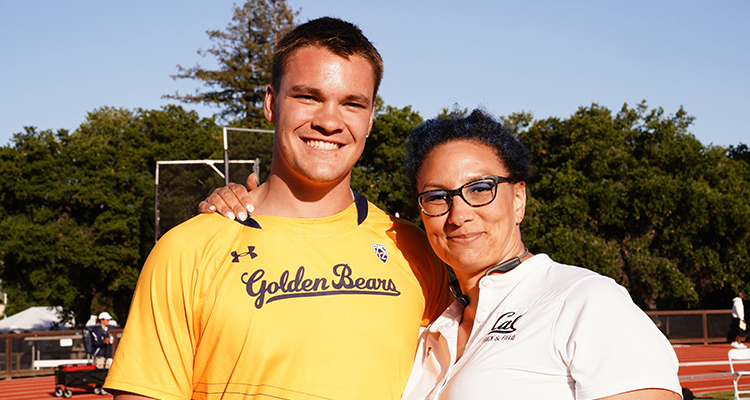
Some athletes are aggressive and like to be fired up, said Saatara, while others are calm and want straightforward feedback. Younger throwers often need more encouragement and reassurance.
“I try to mirror their personalities and learning styles,” he said. “Throwing is a very solitary event. It’s just you in a circle, and off you go. Athletes need to feel that you’re with them. It’s a two-way street. I tell them, ‘I’m with you. We’re going to do this together.’”
For some coaches, said Pierson, coaching is about ego or having power. But that’s not the motivation for Saatara.
“It’s not about him,” she said. “He’s a coach with the intent of being the best coach that ever coached.”
‘Wherever Mo’s at, that’s where I’ll be’
At the U.S. Olympic Team Trials for track and field events last month in Eugene, Oregon, two Cal throws athletes — Bruckner and Jasmine Blair, who has a bachelor’s degree in architecture from Berkeley — competed in discus.
Although Bruckner narrowly missed making the U.S. team, she credits Saatara with getting her to a place where she’s competing with the best in the world.
“Coach Mo saw my potential and took a chance on me,” she said.
After setting records at her San Jose high school, Bruckner had an unremarkable throwing career at the University of Texas, Austin. When she was no longer eligible to compete as a student, the program didn’t give her the opportunity to keep training with the team. So when Saatara agreed to coach her as a post-collegiate athlete, it gave her the confidence she needed to keep pursuing a career in throws.
Brucker began working with Saatara in 2021, and they spent a year breaking down her technique — “I was falling all the time,” she said — and building it back up. Now, she throws seven meters farther than when she started.
“I’m way more fluid and comfortable in the ring now,” said Bruckner. “When I go through phases like that again in training, where it feels messy and I don’t know how this is going to come together, I know I have to trust the process and stick with it — it’ll come together.”
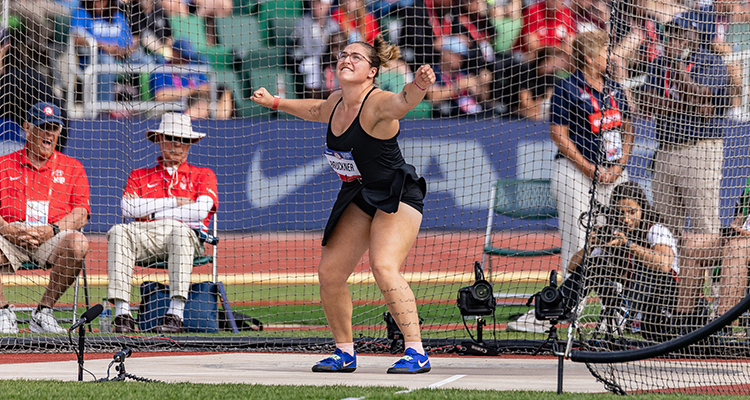
Pierson said training alongside post-collegiate athletes gives student-athletes, like Godbehere, an idea of what their careers after college could look like. Not only do most professional track and field athletes have full-time jobs and finance their own competitive events, they also have to hold themselves accountable without the built-in support of a team.
“All the professional athletes, they work so hard, and they’re at the top right now,” said Godbehere. “It’s so cool to see them getting the attention they deserve.”
Godbehere plans to have a long career in shot put after he graduates. He wants to make U.S. teams and go to the Olympics one day. He knows it’ll take time and a lot of hard work to build up his technique before he’s ready, but he knows he can do it — as long as Saatara is there, supporting him along the way.
“Wherever Mo’s at, that’s where I’ll be,” he said.
